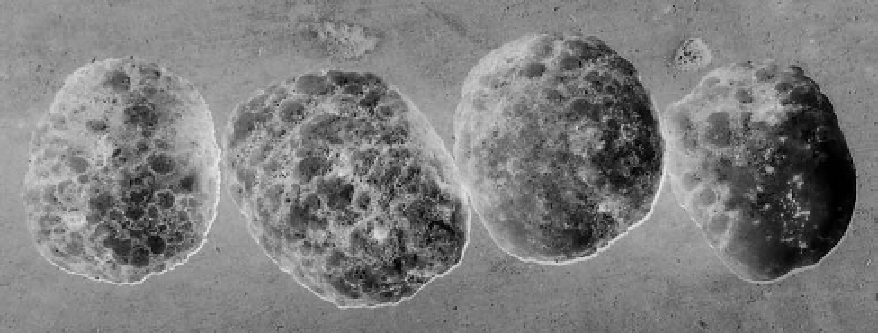Agriculture Reference
In-Depth Information
and
M. fallax
(De Weerdt
et al
., 2011). Mature
female nematodes can also be found in the galls
formed in the tubers, below the potato skin. Necrotic
spots can be observed in the region between the
tuber surface and the vascular ring. In all cases,
the tuber surfaces could be deformed with swell-
ings, which may have a warty appearance,
resulting in a reduction of tuber quality and
ally, more than one generation can occur during
the season, with the first generation occurring in
the roots, while the subsequent generations are
able to attack potato tubers (Charchar
et al
., 2009).
Diagnostics and identification for these spe-
cies is difficult. However, several references for
the genus are very useful for species identifica-
tion based on morphology (Hirschmann, 1985;
Hunt and Handoo, 2010). Additionally, female
isoenzyme characterization and molecular methods
based on polymerase chain reaction (PCR) have
proven to be very useful in species identification
(Blok and Powers, 2010).
Bolivia, Chile, and Peru. This potato pathotype
can cause severe damage to potato, with yield
losses reported averaging 65% in the Andean re-
gions of Latin America and 36% for bean in
Mexico (Otazú
et al
., 1985; Manzanilla-López
et al
., 2002). Aboveground symptoms are not
specific, but plants are weak and stunted. In-
fested roots show strings of galls that may look
similar to
Meloidogyne
-infested roots. False RKNs
can survive under the skin of the tuber, acting as
a source of new infestations. These nematodes
are listed as quarantine organisms by many
countries because of the severe damage they can
cause to various crops, and especially potato.
The false RKNs are endoparasitic and
migratory, invading roots and tubers where
they feed, migrate, and develop, causing lesions,
necrosis, and cavities. Females reinvade healthy
roots, where they become sedentary and estab-
lish permanent feeding sites, producing root
galls, and following fertilization, producing egg
masses. The third- and fourth-stage juveniles
can become dormant in roots and tubers, surviv-
ing in adverse conditions and facilitating their
dispersal (Manzanilla-López
et al
., 2002).
False root-knot nematodes,
Nacobbus aberrans
Root-lesion nematodes -
Pratylenchus
spp.
The false RKN,
N. aberrans
is a species complex
that has a wide host range including potatoes,
sugarbeets, beans, peppers, crucifers, and to-
mato, and in which host specialization is found.
They occur in temperate and tropical regions of
North and South America. Different pathotypes
have been described, and the potato pathotype is
specialized on Solanaceous hosts and occurs in
Mexico and the Andean regions of Argentina,
Ten root-lesion nematode species,
Pratylenchus
spp.,
are known to parasitize potato:
P. brachyurus
,
P. coffea
,
Pratylenchus crenatus
Loof, 1960;
Praty-
lenchus neglectus
(Rensch, 1924) Filipjev and
Schuurmans-Stekhoven, 1941;
Pratylenchus thornei
Sher and Allen
,
1951;
Pratylenchus scribneri
Fig. 10.2.
Potato tubers infected by
Meloidogyne javanica
exhibiting the characteristic galls and
deformed surface. (Photo courtesy of C.M.G. Oliveira.)

